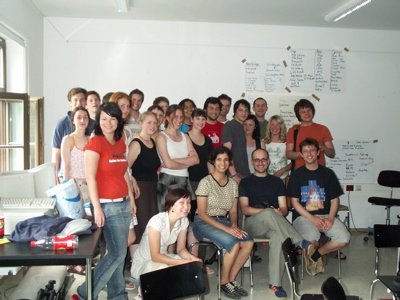I’m back from a week long germany trip which took me to Weimar and Berlin. In Weimar I was invited by Prof. Alexander Branczyk (ex Meta-Designer and Founder of Xplicit and the type foundry F2F) to hold a 2 day workshop on cross cultural design with the students of the Bauhaus University. After bombarding the students with visuals and ideas about the Arab world, my workshop colleague Marla Luther of Brandicate gave the students the assignment of designing a visual identiy for an Arab-Western Summit of Skills conference. Whoever develops the best design will come to our company SYNTAX in Amman for an internship.
In Berlin I also met with 2 partners from the design bureau Moniteurs, Heike Nehl and Sibylle Schlaich. It was really great to finally to meet all these talented people after following their work on the web for the past years!
For those of you interested in more information about the Bauhaus workshop.. here’s a really long press release about it.. ![]()



Amman, Monday, June 7, 2004
When ‘German design’ is mentioned, most people’s minds immediately conjure up images of well-crafted automobiles. German cars epitomize the best-known qualities of German design and industry: rigor, quality and innovation.
Beyond the obvious example of the automobile, German design and innovation have helped shape much of our modern world: Just think about Gutenberg’s invention of the moveable-type printing press 550 yeas ago, sparking off the information revolution.
One of the most profound influences of German design on 20th century aesthetics was the Bauhaus. Founded in Weimar by architect Walter Gropius in 1919, the Bauhaus school revolutionized the visual arts, architecture and industrial design by advocating a “union of art and technology”. By focusing on the beauty in functionalism and calling for an end to superfluous ornamentation, Gropius and his contemporaries heralded in the age of modernism, still so influential in design, architecture and planning today. The heirs of the Bauhaus legacy have continued to shape our visual landsape. Take, for example, the late German designer Otl Aicher the designer of a dazzling array of visual communication designs, logos, typefaces (even kitchen systems) and the inventor the modern sport pictograms, which he designed for the 1972 Olympics.
It is this epic legacy of design that will be on the mind of Ahmad Humeid, Founder and Design Director of integrated-design company SYNTAX, when he visits the Bauhaus University in Weimar this June. Humeid along with Marla Luther, Managing Partner of the Berlin-based communications consulting firm Brandicate Consultants have been invited to the Bauhaus University to hold a unique workshop on “Cross Cultural Design” by Professor Alexander Branczyk, one of Germany’s leading designers and typographers.
Branczyk and his associate Daniel Schmidt were intrigued by Humeid’s groundbreaking work in the field of cross-cultural design and the high standards of SYNTAX’s projects. He encouraged Humeid and his German colleague to put together a rigorous two-day workshop consisting of a dynamic mix of presentations and collaborative sessions with Bauhaus students. The workshop will explore idea of an “Arab-Western visual” fusion through investigations of Arabic typography and how it has been affected by western technologies and what happens when “Western brands go east.”
Humeid says that “media images of the ‘other’ play a dominant role in shaping people’s perceptions of other cultures. Only by delving deeper in the reality of a foreign culture and challenging the media driven clichés, can a meaningful dialogue und understanding occur.” One of the aims of the workshop is to get students to explore their own perceptions of the Arab world and get acquainted with current debates on identity and representation within Arab societies.
“This workshop represents another milestone in our ongoing collaboration with German clients and German designers,” says Humeid. He’s no stranger to the mentioned themes. Both Humeid and his business partner at SYNTAX Salua Qidan are of Arab and German family origins, and are professionally involved in numerous bilingual and cross-cultural design projects for clients such as the German embassy in Jordan, the German Agency for Technical Cooperation (GTZ) and several German NGOs.
Humeid’s expertise in cross-cultural design and communication, has led him to numerous speaking engagements at international media and design conferences in Europe, the US and the Arab world, most notably the TYPO, Europe’s largest design conference held annually in Berlin, Germany.
As part of its ongoing effort to bring German design expertise to Arabia, SYNTAX has invited Professor Rayan Abdullah, of Iraqi decent and one of Germany’s best known corporate design/corporate identity experts to give a series of presentations in Jordan earlier this year. Abdullah’s projects in his own firm Markenbau and previously as Senior Designer at MetaDesign, Germany’s leading design and branding company, include comprehensive corporate design work for the Berlin Transport Authority, Volkswagen, Bugatti and the German Federal Government ? for whom he re-vamped the German Eagle symbol.
“The reaction to Professor’s Abdullah’s visit was overwhelmingly enthusiastic. His message of rigorous, utilitarian and human-centered design and communication is one that Arab organizations need to adopt. Many Arab designers are also starting to see their role as more than mere decorators or creators of vanity artifacts,” says Humeid.
The Arab world is a major importer of German goods, making it necessary for German companies to communicate intelligently with Arab audiences. On the other hand companies and institutions in the Arab world are in need of increased rigor and systematic thinking when it comes to their identity and communication, something that German expertise can help provide.
“Both German and Arab companies can benefit from the bridging of talent and expertise that SYNTAX is actively pursuing. What we offer them is the fusion of deep understanding of local communication sensibilities and world-class design solutions that go beyond slick-looking logos and flashy graphics,” asserts Humeid.
Comments
One response to “Designing a bridge from Germany to Arabia”
Hi Ahmad.
Nice article! The pic of the Coke bicycle seriously is funny!
One question – are any German design companies already working in Arabia?